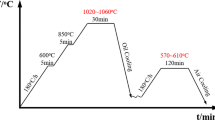Abstract
In the present work, the effect of quenching and tempering processes on the sharpness performance of 6Cr13 high-carbon martensitic stainless steel knives was investigated. The results show that the sharp persistence of the knife increases as the quenching temperature increases from 975 to 1125 °C. The initial sharpness first increases and then decreases, reaching a maximum of 95.9 mm at 1075 °C. When the tempering temperature is below 300 °C, the initial sharpness and sharp persistence of the knife both decrease with the increase of tempering temperature. The secondary carbide in the steel dissolved and the carbide content decrease continuously with the increase of quenching temperature. After the quenching temperature exceeds 1050 °C, a large amount of secondary carbide solid solution is formed into the austenite. The carbides precipitate from steel matrix after the tempering temperature exceeds 400 °C. The refinement and dissolution of secondary carbides are the main reasons for the good sharpness performance of 6Cr13 steel knives. The variation of hardness has little effect on the sharpness performance. However, the cutting capacity of knives fluctuates more sharply as the hardness decreases. Quenching at 1050–1075 °C and tempering at 180–220 °C can obtain 6Cr13 steel knives with optimal sharpness, hardness and fine grain size combination.

















Similar content being viewed by others
References
McGorry R W, Dowd P C, and Dempsey P G, Appl Ergon 34 (2003) 375. https://doi.org/10.1016/S0003-6870(03)00041-3
Reilly G A, McCormack B A O, and Taylor D, J Mater Process Technol 153 (2004) 261. https://doi.org/10.1016/j.jmatprotec.2004.04.297
Su Z, Huang T, and Fan L, Mater Sci Eng 472 (2019) 012054
Marsot J, Claudon L, and Jacqmin M, Appl Ergon 38 (2007) 83. https://doi.org/10.1016/j.apergo.2005.12.007
Zhu Q, Li J, and Zhang J, J Mater Eng Perform 28 (2019) 4511. https://doi.org/10.1007/s11665-019-04209-6
Wu D, Zhang Q, and Liu W, Metals 12 (2022) 472. https://doi.org/10.3390/met12030472
Roscioli G, Taheri-Mousavi S M, and Tasan C C, Science 369 (2020) 689. https://doi.org/10.1126/science.aba9490
Cobb H M, The History of Stainless Steel, Geauga County, ASM International (2010), p 1.
Lo K H, Shek C H, and Lai J K L, Mater Sci Eng R Rep 65 (2009) 39. https://doi.org/10.1016/j.mser.2009.03.001
Li J, and Shi C, Carbide in Special Steel, Springer, Singapore (2021), pp 1–57.
Chen C Y, Hung F Y, and Lui T S, Metals 6 (2016) 35. https://doi.org/10.3390/met6020035
Zhu Q, Li J, and Shi C, J Mater Eng Perform 24 (2015) 4313. https://doi.org/10.1007/s11665-015-1723-7
Park J Y, and Park Y S, Corrosion (2006). https://doi.org/10.5006/1.3279913
Yuan L L, Han J T, and Liu J, Appl Mech Mater 401 (2013) 916. https://doi.org/10.4028/www.scientific.net/AMM.401-403.916
Siqueira J S, de Abreu Alves M R, and Marcial Luiz T, Mater Corros 72 (2021) 1752. https://doi.org/10.1002/maco.202112483
Ma D, Chi H, and Zhou J, J Iron Steel Res Int 19 (2012) 56. https://doi.org/10.1016/S1006-706X(12)60074-0
Speich G R, and Leslie W C, Metall Trans 3 (1972) 1043. https://doi.org/10.1007/BF02642436
Huang Q, Yao M, and Timokhina I, Metall Mater Trans A 50 (2019) 3663. https://doi.org/10.1007/s11661-019-05272-3
Vitek J M, and Klueh R L, Metall Trans A 14 (1983) 1047. https://doi.org/10.1007/BF02670443
GB/T 8362-1987, Retained Austenite in Steel-Quantitative Determination-Method of X-ray Diffractometer, Bei**g, China (1987).
ISO, ISO 8442-5, Materials and Articles in Contact with Foodstuffs—Cutlery and Table Holloware—Part 5: Specification for Sharpness and Edge Retention Test of Cutlery.
Yang Y, Zhao H, and Dong H, J Mater Eng Perform 29 (2020) 3868.
Zhu Q T, Li J, Zhang J, and Shi C B, J Mater Eng Perform 28 (2019) 4511.
Gilbert R, in International Symposium Held at the 34th Mechanical Working and Steel Processing Conference, Montreal, Quebec, Canada, Iron and Steel Society (1992).
Krishna S C, Gangwar N K, and Jha A K, J Mater Eng Perform 24 (2015) 1656. https://doi.org/10.1007/s11665-015-1431-3
Kashyap B P, and Tangri K, Acta Metall Mater 43 (1995) 3971. https://doi.org/10.1016/0956-7151(95)00110-H
Li X, Ma X, and Subramanian S V, Mater Sci Eng A 616 (2014) 141. https://doi.org/10.1016/j.msea.2014.07.100
Morito S, Saito H, and Ogawa T, ISIJ Int 45 (2005) 91. https://doi.org/10.2355/isi**ternational.45.91
Acknowledgements
This work was supported by the National Nature Science Foundation of China (Grant No. 51874030), the Guangdong Yang Fan Innovative & Entrepreneurial Research Team Program (Grant No. 2016YT03C071) and the Guangdong Science and Technology Special Fund Project (Grant No. SDZX202005).
Author information
Authors and Affiliations
Corresponding author
Ethics declarations
Conflict of interest
The authors declare that no conflicts of interest and ethical rules could have appeared to influence the work reported in this paper.
Additional information
Publisher's Note
Springer Nature remains neutral with regard to jurisdictional claims in published maps and institutional affiliations.
Rights and permissions
Springer Nature or its licensor (e.g. a society or other partner) holds exclusive rights to this article under a publishing agreement with the author(s) or other rightsholder(s); author self-archiving of the accepted manuscript version of this article is solely governed by the terms of such publishing agreement and applicable law.
About this article
Cite this article
Zhu, S., Li, J., Li, S. et al. Effect of Quenching and Tempering Processes on Sharpness of Knives Made from 6Cr13 High-Carbon Martensitic Stainless Steel. Trans Indian Inst Met 77, 81–93 (2024). https://doi.org/10.1007/s12666-023-03058-1
Received:
Accepted:
Published:
Issue Date:
DOI: https://doi.org/10.1007/s12666-023-03058-1




